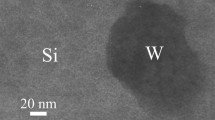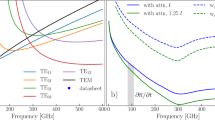Abstract
We describe the theory, fabrication, operation, and performance of a cylindrical dc SQUID made with shunted Nb-NbOx-Pb Josephson tunnel junctions. The SQUID is current-biased at a nonzero voltage, and modulated with a 100 kHz flux. The 100 kHz voltage developed across the SQUID is amplified by a cooled, resonantLC circuit that optimally couples the SQUID impedance to the input of a room-temperature FET preamplifier. The SQUID is operated in a flux-locked loop with a dynamic range in a 1-Hz bandwidth of ±3×106. The 3-dB rolloff frequency for the loop response is typicalty 2 kHz, and the slewing rate is generally 2×104 φ0 sec−1. A typical flux noise power spectrum for a SQUID at 4.2 K in a superconducting shield is presented. Above 2×10−2 Hz the spectrum is white and has an rms value of 3.5×10−5 φ0 Hz−1/2. The white noise is intrinsic to the sensor and is close to the theoretical limit set by Johnson noise in the shunts. At lower frequencies, the power spectrum is approximately 10−10 (1 Hz/f) φ 20 Hz−1, wheref is the frequency. This value is approximately two orders of magnitude greater than the calculated 1/f noise in the tunnel junctions. The factors contributing to the long-term drift of the SQUID are discussed. By regulating the temperature of the helium bath we have achieved a drift rate of 2×10−5 φ0 h−1 over a 20-h period. A detailed description is given of the coupling efficiency of various input coils wound on the SQUID. The effects of coupling between the input coil, the SQUID, and the feedback (modulation) coil are described, and measurements of the coupling parameters reported. The energy resolution of the SQUID with respect to a current in a 24-turn input coil is 7×10−30 J Hz−1 for frequencies at which the flux noise has a white power spectrum. In terms of energy resolution, the SQUID has a better performance in the 1/f noise region that that of any SQUID previously reported in the literature. The long-term drift over an extended period also represents the lowest value yet reported.
Similar content being viewed by others
References
B. D. Josephson,Phys. Lett. 1, 251 (1962);Adv. Phys. 14, 419 (1965).
R. C. Jaklevic, J. Lambe, A. H. Silver, and J. E. Mercereau,Phys. Rev. Lett. 12, 159 (1964).
J. E. Zimmerman and A. H. Silver,Phys. Rev. 141, 367 (1966).
M. R. Beasley and W. W. Webb, inProc. Symp. Physics of Superconducting Devices (Univ. of Virginia, Charlottesville, April 28–29, 1967), Vol. 1.
P. L. Forgacs and A. Warnick,Rev. Sci. Inst. 38, 214 (1967).
J. Clarke,Phil. Mag. 13, 115 (1966).
J. E. Zimmerman, P. Thiene, and J. T. Harding,J. Appl. Phys. 41, 1572 (1970).
J. E. Mercereau,Rev. Phys. Appl. 5, 13 (1970); M. Nisenoff,Rev. Phys. Appl. 5, 21 (1970).
R. P. Giffard, R. A. Webb, and J. C. Wheatley,J. Low Temp. Phys. 6, 533 (1972).
J. Kurkijärvi,Phys. Rev. B 6, 832 (1972); J. Kurkijärvi and W. W. Webb, inProc. Appl. Superconductivities Conference, Annapolis (IEEE, New York, 1972), p. 581; J. Kurkijärvi,J. Appl. Phys. 44, 3729 (1973); L. D. Jackel and R. A. Buhrman,J. Low Temp. Phys. 19, 201 (1975).
J. Clarke,Proc. IEEE 61, 8 (1973).
P. K. Hansma, G. I. Rochlin, and J. N. Sweet,Phys. Rev. B 4, 3003 (1971).
J. E. Nordman,J. Appl. Phys. 40, 2111 (1969); J. E. Nordman and W. H. Keller,Phys. Lett. 36A, 52 (1971); L. O. Mullen and D. B. Sullivan,J. Appl. Phys. 40, 2115 (1969); R. Graeffe and T. Wiik,J. Appl. Phys. 42, 2146 (1971); K. Schwidtal,J. Appl. Phys. 43, 202 (1972); P. K. Hansma,J. Appl. Phys. 45, 1472 (1974); S. Owen and J. E. Nordman,IEEE Trans. Magn. MAG-11, 774 (1975).
V. Radhakrishnan and V. L. Newhouse,J. Appl. Phys. 42, 129 (1971).
A. Th. A. M. De Waele and R. De Bruyn Ouboter,Physica 41, 225 (1969).
M. Tinkham,Introduction to Superconductivity (McGraw-Hill, New York, 1975), p. 214.
R. A. Webb, R. P. Giffard, and J. C. Wheatley,J. Low Temp. Phys. 13, 383 (1973).
J. Clarke, W. M. Goubau, and M. B. Ketchen,IEEE Trans. Magn. MAG-11, 724 (1975);Appl. Phys. Lett. 27, 155 (1975); inProc. 14th Int. Conf. Low Temp. Phys. (Helsinki, Finland, 1975) (North-Holland, Amsterdam), Vol. 4, p. 214.
W. C. Stewart,Appl. Phys. Lett. 12, 277 (1968).
D. E. McCumber,J. Appl. Phys. 39, 3113 (1968).
J. Clarke and J. L. Paterson,Appl. Phys. Lett. 19, 469 (1971).
Y. H. Ivanchenko and L. A. Zil'berman,Zh. Eksp. Teor. Fiz. 55, 2395 (1968) [Soviet Phys.—JEPT 28, 1272 (1969)].
V. Ambegaokar and B. I. Halperin,Phys. Rev. Lett. 22, 1364 (1969).
A. N. Vystavkin, V. N. Gubankov, L. S. Kuzmin, K. K. Likharev, V. V. Migulin, and V. K. Semenov,Rev. Phys. Appl. 9, 79 (1974).
C. M. Falco, W. H. Parker, S. E. Trullinger, and P. K. Hansma,Phys. Rev. B 10, 1865 (1974).
M. D. Fiske,Rev. Mod. Phys. 36, 221 (1964).
A. Davidson, R. S. Newbower, and M. R. Beasley,Rev. Sci. Instr. 45, 838 (1974).
K. K. Likharev and V. K. Semenov,JETP Lett. 15, 442 (1972).
T. A. Fulton,IEEE Trans. Magn. MAG-11, 749 (1975).
J. Clarke and G. A. Hawkins,IEEE Trans. Magn. MAG-11, 724 (1975).
J. Clarke and R. F. Voss,Phys. Rev. Lett. 33, 24 (1974); R. F. Voss and J. Clarke,Phys. Rev. B 13, 556 (1976).
J. E. Zimmerman,J. Appl. Phys. 42, 4483 (1971).
J. M. Pierce, J. E. Opfer, and L. H. Rorden,IEEE Trans. Magn. MAG-10, 599 (1974).
J. H. Claassen,J. Appl. Phys. 46, 2268 (1975).
F. W. Grover,Inductance Calculations: Working Formulas and Tables (Dover, New York, 1962), pp. 142–150.
G. A. Hawkins and J. Clarke,J. Appl. Phys. 47, 1616 (1976).
T. D. Clark and L. D. Jackel,Rev. Sci. Instr. 46, 1249 (1975).
S. Letzter and N. Webster,IEEE Spectrum 7, 62 (1970).
Author information
Authors and Affiliations
Rights and permissions
About this article
Cite this article
Clarke, J., Goubau, W.M. & Ketchen, M.B. Tunnel junction dc SQUID: Fabrication, operation, and performance. J Low Temp Phys 25, 99–144 (1976). https://doi.org/10.1007/BF00654826
Received:
Issue Date:
DOI: https://doi.org/10.1007/BF00654826




